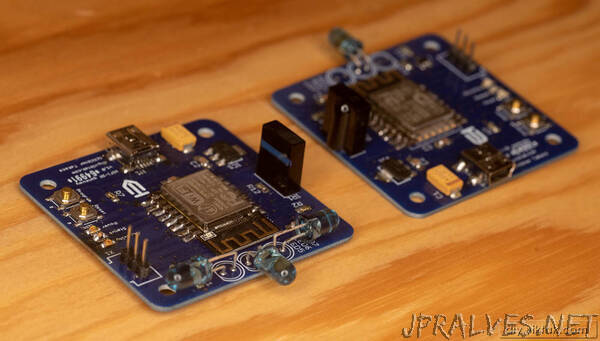
“Some time ago I also completed this project that I never got around to publish. This project is a WiFi-Infrared gateway. I am aware that such commercial products exist, but at the time I needed one for my home the available options all suffered from one or more shortcomings, such as being open source, working with my own (very old) IR-capable devices, cheap (I wanted several pieces, one for each room in my house), etc. So I decided to build my own. this also had the added benefit of learning about IR communications, etc. Below is a recap how I went about it, what difficulties I have encountered and a detailed description of the project should one want to make one. The whole project is now open source.
Hardware
My WiFi-IR gateway is designed around the well known and documented ESP8266 based ESP-12F module. The circuit is rather simple, consisting of only a few parts apart from the ESP-12F module. These are the main groups of parts on the custom built PCB:
Power circuitry: Takes 5V DC via a USB Mini-B socket from any USB phone charger and delivers 3.3V to the rest of the circuit.
ESP-12F module with its “mandatory” company of Reset and Programming buttons etc.
IR receiver to “learn” new codes from (almost) any IR device.
IR transmitter circuitry including the IR LEDs and their driver, which in this simple case, is a simple transistor in switch mode.
What caused me a bit of grief is that, as I learnt the hard way with a lot of experimenting, not all IR LEDs are created equal: When preparing for this project, on the breadboard, I used an old IR LED that I had recovered from an old and thrown away TV remote control. Sending IR commands across the room, even without pointing directly at the receiver, worked perfectly. For the final item, though, I ordered some IR LEDs (of the same wavelength) from eBay. Unfortunately, these LEDs performed very poorly: First I thought they were completely broken, but then I realized that if I place the transmitter LEDs within a cm or so to the receiver, then my circuit worked. I got like a 100 such LEDs, so I tried a few more, but they all performed the same way. I was convinced that they were faulty, so I got another batch from another supplier. when they arrived, however, I was disappointed to see that this new batch was as bad as the first one. THEN I started to do a deeper research on the subject, and I found out that the wavelength (in my case 940nm) is not the only critical parameter. So I ended up buying a few TSAL6400 IR transmitter LEDs from Vishay. When I put just one of them in my circuit it already “illuminated” the whole living room, without having to pointed it to the target receiver. For extra robustness, I have place for 3 pieces of 5mm IR LEDs on my board, although so far haven’t needed more than one in any room for reliable operation.”
